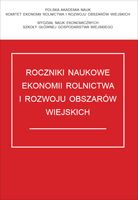Main Article Content
Article Details
Andriessen Daniel, 2004: Making sense of intellectual capital. Desinging a metod for the valuation of intangibles, Elsevier Butterworth Heinemann, Oxford, 364-371.
Dobiegała-Korona Barbara, Herman Andrzej (red.), 2006: Współczesne źródła wartości przedsiębiorstwa, Wyd. Difin, Warszawa, 17-36.
Edvinsson Leif, Malone Michael, 2001: Kapitał intelektualny, Wyd. PWN, Warszawa.
Fijałkowska Justyna: VAIC™ jako metoda pomiaru dokonań przedsiębiorstw, "Prace i Materiały Wydziału Zarządzania UG", nr 1/2013, 63-77, [on-line], http://zif.wzr.pl/pim/2013_1_2_5.pdf, dostęp 23.03.2014.
Grzelak Aleksander, Seremak-Bulge Jadwiga, 2014: Porównanie wybranych metod badania koniunktury w rolnictwie w Polsce, "Zagadnienia ekonomiki rolnej", nr 4 (341), 117-130.
Guzewicz Wacław, Kagan Adam, Zdzieborska Maria, 2006: Procesy dostosowawcze wielkoobszarowych gospodarstwach popegeerowskich (lata 2002-2005), IERiGŻ-PIB, Warszawa.
Iazzolino Gianpaolo, Laise Domenico, 2013: Value added intellectual coefficient (VAIC). A methodological and critical review; "Journal of Intellectual Capital", vol. 14, no. 4, 547-563. (Crossref)
Jóźwiak Wojciech, Kagan Adam, 2008: Gospodarstwa towarowe a gospodarstwa wielkotowarowe. Roczniki Nauk Rolniczych. Seria G, Ekonomika rolnictwa, 95(1), 22-30. (Crossref)
Kasiewicz Stanisław, Rogowski Waldemar, Kicińska Monika, 2006: Kapitał intelektualny spojrzenie z perspektywy interesariuszy, Wyd. Oficyna Ekonomiczna, Kraków, 196-215.
Kasztelan Paweł, 2009: Efektywność ekonomiczna wielkoobszarowych przedsiębiorstw rolniczych, "Journal of Agribusiness and Rural Development", 3(13), 83-90.
Kozera Magdalena, 2014: Efektywność wykorzystania kapitału intelektualnego w przedsiębiorstwach rolniczych Wielkopolski, "Przedsiębiorczość i Zarządzanie", t. XV, z. 6, 165-179.
Kozera Magdalena, Kalinowski Sławomir, 2012: Intellectual capital - non-material element of farm businesses economic success, Proceedings of the International Conference on Management of Human Resources, Management - Leadership - Strategy - Competitiveness, Szent Istvan University, Godollo, Węgry, 405-413.
Kozera Magdalena, Parzonka Mikołaj, 2010: Zasoby kapitału intelektualnego przedsiębiorstwa rolniczego i jego zmiany, "Roczniki Naukowe Stowarzyszenia Ekonomistów Rolnictwa i Agrobiznesu", 7(5), 90-96.
Król Henryk, Ludwiczyński Antoni (red.), 2008: Zarządzanie zasobami ludzkimi. Tworzenie kapitału ludzkiego organizacji. PWE, Warszawa.
McElroy Mark W., 2002: The New Knowledge Management, Complexity, Learning and Sustainable Innovation, Published By Butterworth-Heinema, 17-21.
Mroziewski Marian, 2008: Kapitał intelektualny współczesnego przedsiębiorstwa. Koncepcje, metody wartościowania i warunki jego rozwoju, Wyd. Difin, Warszawa, 49-68.
Nita Bartłomiej, 2007: Metody wyceny i kształtowania wartości przedsiębiorstwa, Wyd. PWE, Warszawa, 46-50, 107-116.
Pulić Ante, 2000: MVA and VAICeAnalysis of Randomly Selected Companies from FTSE 250, Austrian Intellectual Capital Research Center, Graz, on-line: available at: www.measuring-ip.at/Papers/ham99txt.htm, dostęp: 30.11.2011.
Pulić Ante, Bounfour Ahmed, Edvinsson Leiv, (red.), 2005: Value creation efficiency at national and regional levels: case study - Croatia and the European Union, "Intellectual Capital for Communities", Elsevier, Oxford. (Crossref)
Stewart Thomas A. 1991: Brain Power. How Intellectual Capital is Becoming America's Most Valuable Asset, "Fortune", June 3.
Ståhle Pirjo, Ståhle Sten, Aho Samuli, 2011: Value added intellectual coefficient (VAIC): a critical analysis, "Journal of Intellectual Capital", vol. 12, Iss 4, 531-551, [on-line], http://dx.doi.org/10.1108/14691931111181715, dostęp: 16.06.2012. (Crossref)
Sullivan Patrick H., 2000: Value-Driven Intellectual Capital, John Wiley and Sons, New York 2000.
Sveiby Karl E., 1997: The New Organization Wealth, Berrett-Koehler Publishers.
Tan Hong Pew, Plowman David, Hancock Phillip, 2008: The evolving research on intellectual capital, "Journal of Intellectual Capital, vol. 9(4), 585-608. (Crossref)
Wojtaszek Zygmunt, 2008: Problemy mikroekonomii rolnictwa w pięćdziesięcioletniej działalności Komitetu Ekonomiki Rolnictwa PAN. Roczniki Nauk Rolniczych. Seria G, Ekonomika rolnictwa, 94(2), 27-32. (Crossref)
Ziętara Wojciech, 2009: Rachunek kosztów w przedsiębiorstwach rolniczych w teorii i praktyce, "Journal of Agribusiness and Rural Development", vol. 2(12), 303-309.
Downloads
- Zofia Kołoszko-Chomentowska, Leszek Sieczko, ORGANIZATION AND RESULTS OF SMALL AGRICULTURAL HOLDINGS IN THE PODLASIE VOIVODESHIP , Annals of Agricultural Economics and Rural Development: Vol. 102 No. 1 (2015)
You may also start an advanced similarity search for this article.
- Magdalena Kozera, Regional Diversity Of Usage Of EU Financial Support , Annals of Agricultural Economics and Rural Development: Vol. 98 No. 3 (2011)
- Magdalena Kozera, THE DEVELOPMENT OF POLISH AGRICULTURE IN THE REALITIES OF KNOWLEDGE- BASED ECONOMY , Annals of Agricultural Economics and Rural Development: Vol. 100 No. 1 (2013)




